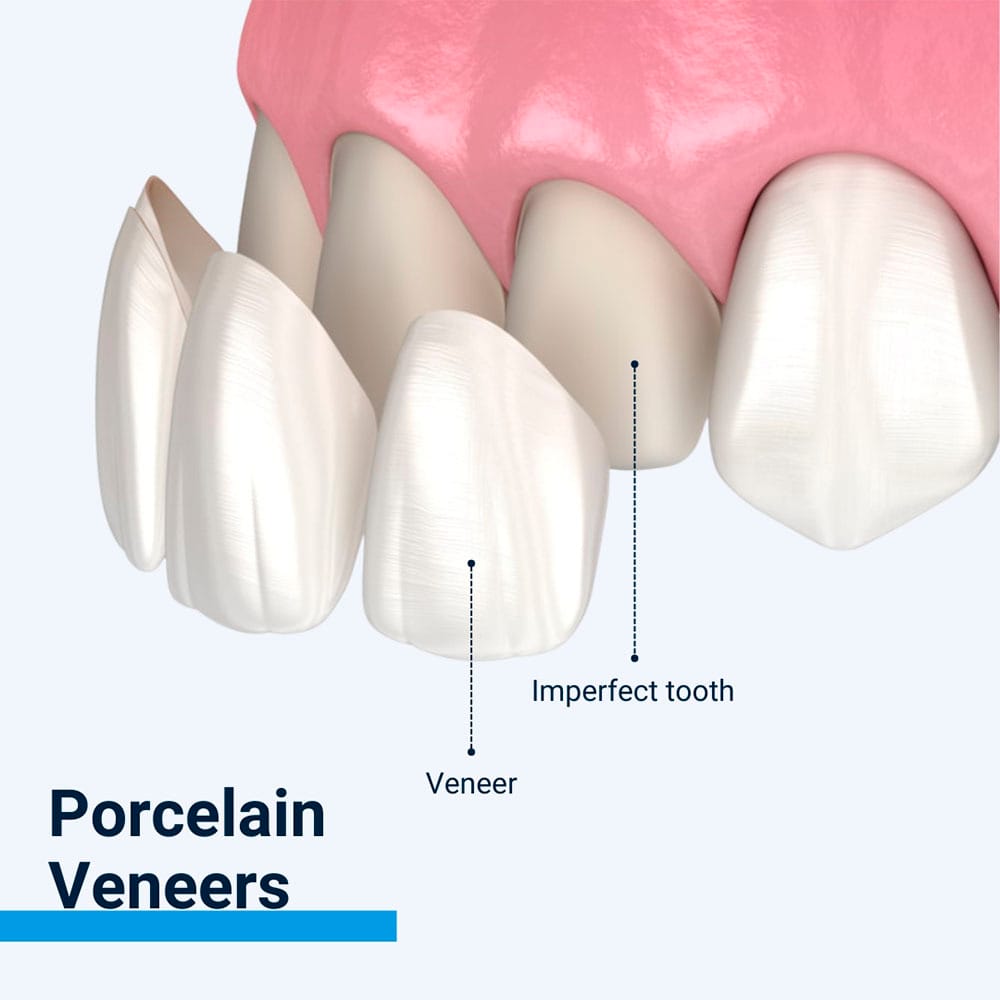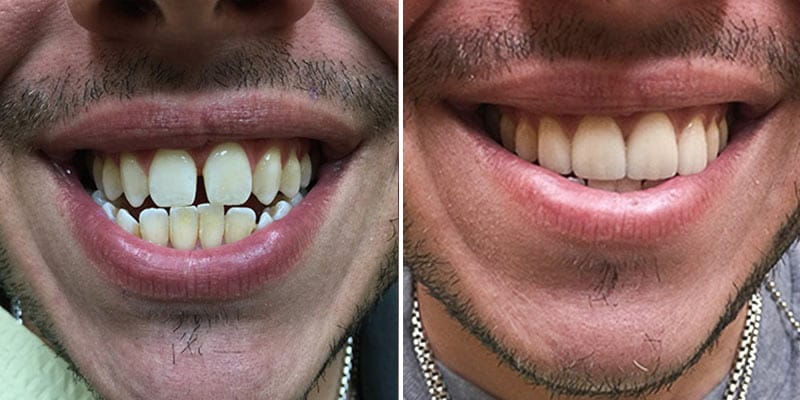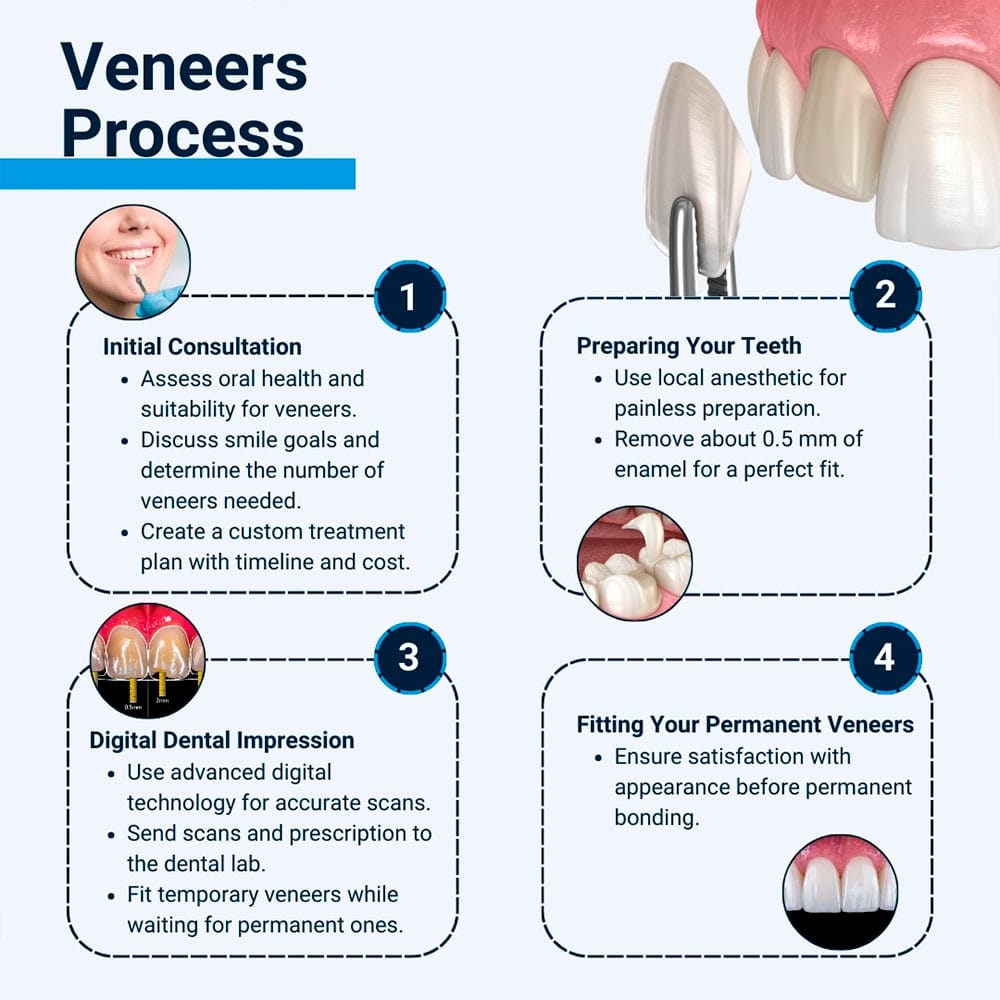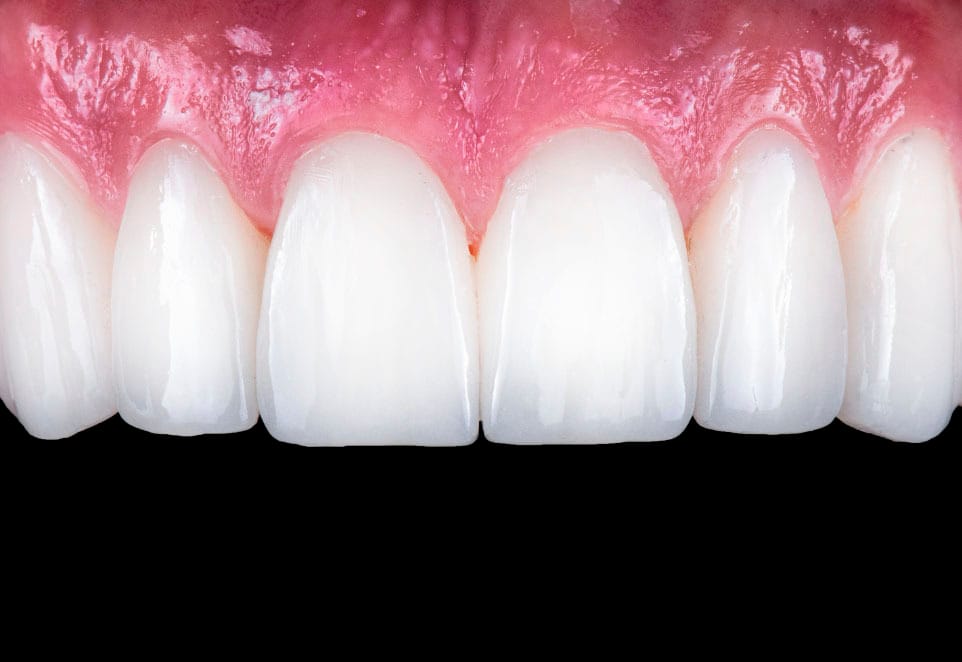What Are Veneers?
 A veneer is designed to cover or veneer the front surface of a tooth, camouflaging it and creating a more perfect size, shape, or color. Treatment is cosmetically oriented, and porcelain veneers (dental laminates) can hide a wide range of imperfections in teeth. These include:
A veneer is designed to cover or veneer the front surface of a tooth, camouflaging it and creating a more perfect size, shape, or color. Treatment is cosmetically oriented, and porcelain veneers (dental laminates) can hide a wide range of imperfections in teeth. These include:
- Chips and cracks
- Tooth discoloration
- Gaps between teeth
- Teeth that are too short or worn
- Slightly misaligned teeth
- Teeth that are too small
- Misshapen teeth
What Are the Benefits of Porcelain Veneers?
Our dental veneers are made from high-quality porcelain, so you receive results that look and feel natural yet are cosmetically pleasing. Porcelain is long-lasting, and it will not stain.
Every treatment is customized, and our experienced cosmetic dentists work closely with our dental lab technicians to create beautiful, unique results.
The treatment process is minimally invasive, although we will likely have to remove some tooth enamel when preparing your teeth. Therefore, it’s important to note that veneers are generally irreversible.

See more photos of porcelain dental veneers before and after.
Who Can Have Porcelain Veneers?
You will need a dental exam before we can recommend this treatment. Dental veneers work best on teeth that are strong and healthy and don’t have any large fillings or cavities. We must also ensure that your gums are healthy.
Any issues that we discover will need to be addressed first. Sometimes, we may recommend an alternative treatment instead of porcelain veneers. For example, a dental crown covering the entire tooth could be a better option if it is significantly chipped, cracked, or missing a substantial part of its structure.
Our dentists will check for signs of other issues like teeth grinding and clenching (bruxism). This nocturnal habit can significantly damage teeth and chip and break a porcelain veneer.
Treating a healthy mouth helps ensure the results last longer. Once we have assessed you are suitable for porcelain veneers, we can start to plan your treatment.
Preparing for Your New Dental Veneers
Several steps are involved in planning and making your veneers, which are outlined below.
-
Initial Consultation
As discussed, we must ensure your mouth is healthy and suitable for porcelain veneers before we proceed. The next stage is learning more about your goals and any particular aspects of your smile you want to correct. Some patients want a dramatic transformation, while others may only need veneers for small teeth to correct minor cosmetic concerns.
We must determine how many veneers are needed. Some people may only wish to have one or two veneers, while others want to achieve a more dramatic transformation, veneering most or all of the front teeth visible when smiling.
We can also discuss whether treatment will be combined with other procedures like teeth whitening. This may be an option if some teeth are perfectly shaped but are merely stained, while others will benefit from being covered with dental veneers.
Once we have this information, we can provide your custom treatment plan outlining how many veneers we think will provide the results you desire. Your custom plan will include the time needed to complete your treatment and how much your dental veneers cost.
At Clock Tower Dental, we welcome questions, so please use this visit to ask us anything you wish about dental veneers.
-
Preparing Your Teeth
We ensure tooth preparation is entirely painless using a local anesthetic to numb your teeth before we begin. Only a tiny amount of tooth structure must be removed, usually about 0.5 mm of tooth enamel. Removing this enamel is necessary to ensure your new veneers look and feel perfect and comfortable.
-
Digital Dental Impression
There is no need to worry about a messy tray impression, as we use the latest digital technology to scan your teeth quickly and comfortably. Digital scans are far more accurate and are transmitted to our dental lab along with the prescription for your dental veneers, including the ideal shade.
Generally, veneers can take up to 2 weeks to be handcrafted, so in the meantime, we fit temporary veneers to protect your teeth.
These temporary veneers look reasonably good and feel comfortable, but they are only fitted with temporary cement, so you must be careful when wearing them. Biting into hard foods could break or dislodge them.
-
Fitting Your Permanent Dental Veneers
Once we receive the veneers from the dental lab you can return to our dental office to have them fitted. We will ensure you are happy with their appearance before bonding them permanently onto your teeth.

How to Care for Your Dental Veneers
You don’t need to do anything different to look after your new veneers. You can brush and floss them just like the rest of your natural teeth. When you visit our dental office, we can clean around them professionally, ensuring they remain strong and continue to look good.
Avoiding habits like biting on ice cubes or biting your nails will help reduce the risk of damaging them. If a habit could damage your teeth, it will likely crack or chip your veneers.
With the right care, your porcelain veneers should last 10 years or more before you need to consider replacing them.
Are There Any Alternatives to Veneers?
You may hear three other types of veneers being discussed: press-on veneers, prepless, and composite resin veneers.
Prepless Veneers (Lumineers)
These veneers do not require any tooth preparation before fitting. They are made from strong porcelain that is even thinner than ordinary veneers but is extremely durable and long-lasting. The best-known brand is called Lumineers. Prepless veneers can sometimes be an option for patients with short or undersized teeth, but traditional veneers for small teeth often provide the best long-term aesthetic outcome.
We may recommend Lumineers in certain circumstances, but prep-free veneers are not suitable for everyone. They can be a great option if you have teeth that need bringing out into alignment or lengthening or if a tooth is too short.
Press-on Veneers
These veneers are removable and snap or clip onto your teeth. No tooth preparation is needed, but they are only temporary and will likely offer unsatisfactory results.
Press-on veneers tend to look large and bulky. They can feel uncomfortable and provide a poor fit. Because they don’t fit very well, they can easily trap food and plaque, increasing your risk of cavities and gum disease.
Composite Resin Veneers
These veneers are applied chairside using tooth-colored composite resin so that treatment can be completed in a single visit. This technique is also called dental bonding, and you can learn more about it on the dedicated webpage.
How Much Do Veneers Cost in Franklin Square, NY?
According to several reputable research companies, the average cost of veneers in Franklin Square ranges from $925 to $2,500 per tooth. Without preparation, veneers will cost around $800 to $2,000 per tooth. In the long run, traditional veneers remain the most cost-effective option.
Discover More about Porcelain Veneers in Franklin Square
Do you have questions about dental veneers or the veneer procedure? For more information or to schedule an appointment, call our dental center at (516) 352-1000. Conveniently located near Rath Park in Franklin Square, NY, Clock Tower Dental is proud to provide expert cosmetic dentistry in a welcoming and accessible location.

